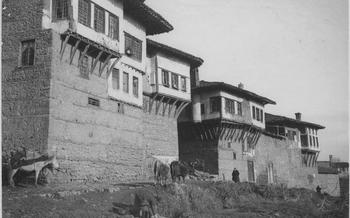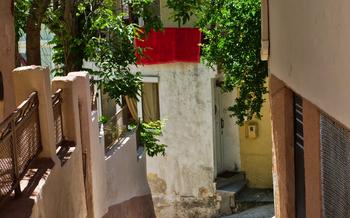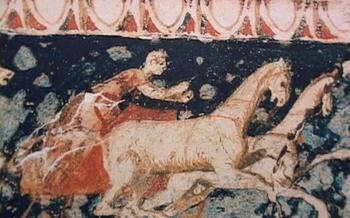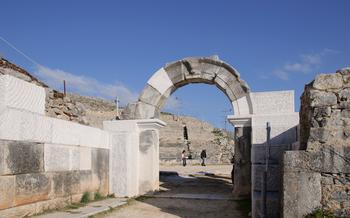
Ancient Theatre of Aigai
- The Ancient City of Aigai
- Exploring the Theatre
- The Plays of Ancient Greece
- Reviving the Ancient Spirit
- The Royal Tombs
- The Discovery
- The Designs
- The Significance
- Ongoing Research
- Conservation Efforts
- Visiting the Tombs
- The Museum of Aigai: A Treasure Trove of Ancient Macedonian History
- Getting There
- Where to Stay
- Where to Eat
- Things to Do Nearby: Exploring the Surrounding Wonders
- History and Culture
- Practical Tips
- Photography Tips
- Insider Tip: Unveiling the Secrets of Ancient Macedonian Cuisine
The Ancient City of Aigai
Aigai, nestled in the picturesque region of Kozani, Greece, holds an esteemed place in the annals of ancient history. Once the resplendent capital of the mighty kingdom of Macedonia, Aigai served as the seat of power for centuries, leaving behind a rich legacy that continues to captivate history buffs and travelers alike.
Excavations at Aigai have unearthed a treasure trove of archaeological wonders, including the awe-inspiring royal tombs of the Macedonian kings. These lavishly adorned burial chambers, adorned with intricate frescoes, sculptures, and architectural marvels, offer a glimpse into the opulence and artistry of ancient Macedonian royalty. Among them, the tomb of Philip II, Alexander the Great's father, stands out as a testament to the grandeur and splendor of this ancient civilization.
Strategically positioned at the crossroads of significant trade routes linking the Balkans, Asia Minor, and the Aegean Sea, Aigai flourished as a vibrant commercial hub. This strategic location facilitated the exchange of goods, ideas, and cultural influences, contributing to the city's growth and prosperity.
Aigai is also steeped in myth and legend, adding an enchanting aura to its allure. According to Greek mythology, the city was founded by Aigialeus, the son of the river god Achelous, and was named after him. Myths and legends intertwine with historical facts, creating a captivating tapestry that invites visitors to delve deeper into the rich narrative of Aigai's past.
Exploring the Theatre
The Ancient Theatre of Aigai, nestled amidst the picturesque landscapes of Macedonia, stands as a testament to the region's rich cultural heritage. Constructed in the 4th century BC, this impressive structure boasts remarkable architectural features and design elements that transport visitors back in time.
The theatre, built primarily from local limestone, features a well-preserved orchestra, or central performance space, surrounded by tiers of seating arranged in a semicircular formation. These seating areas, known as the cavea, were divided into sections based on social status, with the front rows reserved for dignitaries and officials.
The theatre's seating capacity is estimated to have been around 7,000 spectators, making it one of the largest ancient theatres in Macedonia. The acoustics of the theatre are exceptional, ensuring that the voices of actors and musicians could be heard clearly throughout the auditorium.
Originally, the theatre served multiple purposes, hosting a variety of performances and civic events. It was a central venue for dramatic productions, including tragedies, comedies, and satyr plays, which were popular forms of entertainment in ancient Greece. The theatre also hosted musical performances, poetry readings, and political assemblies, serving as a focal point for cultural and civic life in Aigai.
Today, the Ancient Theatre of Aigai has undergone extensive restoration efforts, preserving its grandeur and allowing visitors to experience its original splendor. While performances are no longer held in the theatre, it remains a popular tourist attraction, offering a glimpse into the vibrant cultural traditions of ancient Macedonia.
The Plays of Ancient Greece
Ancient Greek theatre was a vibrant and integral part of society, serving as a platform for entertainment, education, and cultural expression. Various types of plays were performed, each with its unique characteristics and purpose.
Tragedies, often exploring themes of fate, suffering, and the human condition, were particularly popular. Renowned playwrights like Aeschylus, Sophocles, and Euripides crafted powerful tragedies that delved into the complexities of human nature and the interplay between gods and mortals.
Comedies, on the other hand, provided a lighter counterpoint to tragedies. They often employed humor, satire, and social commentary to poke fun at human follies and societal norms. Aristophanes, the master of ancient Greek comedy, was known for his witty and biting critiques of contemporary politics and social issues.
Satyr plays, a unique genre that combined elements of tragedy and comedy, were often performed as a concluding piece to a trilogy of tragedies. They featured mythical creatures called satyrs and often included bawdy humor and slapstick comedy.
These plays explored a wide range of themes, delving into mythology, politics, philosophy, and human nature. They provided a platform for social commentary and encouraged critical thinking among the audience. The cultural and social impact of theatre in ancient Greek society was profound, shaping moral values, fostering civic engagement, and contributing to the development of Western drama.
Reviving the Ancient Spirit
In the footsteps of the ancient Greeks, the Ancient Theatre of Aigai reverberates once again with the power of drama. Modern performances and festivals bring to life the timeless works of Aeschylus, Sophocles, Euripides, and Aristophanes, transporting audiences back to the golden age of Greek theatre. These productions are not mere imitations but vibrant interpretations that resonate with contemporary audiences, exploring universal themes that transcend time.
Reviving ancient Greek drama in a contemporary context presents both challenges and opportunities. The challenge lies in striking a balance between authenticity and accessibility, ensuring that the plays remain faithful to their original spirit while resonating with modern audiences. The opportunity lies in using theatre as a medium to promote cultural exchange, foster dialogue, and bridge the gap between the ancient and the modern world.
Efforts to promote and educate audiences about the legacy of ancient Greek theatre play a crucial role in ensuring its continued relevance. Through workshops, lectures, and educational programs, theatre companies and cultural institutions strive to deepen the understanding and appreciation of this art form. The aim is not merely to showcase ancient plays but to ignite a passion for theatre, inspire creativity, and cultivate a new generation of theatre enthusiasts.
Experiencing a play in an ancient theatre is not just a cultural event but a deeply emotional and transformative experience. The unique atmosphere of these ancient venues, with their evocative acoustics and stunning backdrops, transports audiences to another time and place, creating a sense of awe and wonder. It is an opportunity to connect with the past, immerse oneself in the stories and emotions of ancient characters, and gain a deeper understanding of the human condition.
The Royal Tombs
In the heart of the Archaeological Park of Aigai, a remarkable discovery awaits: the royal tombs of the Macedonian kings, including the legendary Philip II and his son, Alexander the Great. Unearthed by archaeologists in the late 1970s, these elaborate underground chambers offer a glimpse into the opulence and artistry of the ancient Macedonian rulers.
The Discovery
The excavation of the royal tombs was a groundbreaking moment in archaeological history. Led by renowned Greek archaeologist Manolis Andronikos, the team uncovered a series of six tombs, each adorned with intricate frescoes, sculptures, and architectural elements. The most impressive among them is the tomb of Philip II, featuring a vaulted ceiling decorated with a stunning chariot scene.
The Designs
The tombs showcase the exceptional craftsmanship and artistic prowess of the ancient Macedonians. The walls are adorned with vibrant frescoes depicting mythological scenes, hunting expeditions, and battlefields. These murals offer valuable insights into the beliefs, customs, and daily life of the Macedonian royalty.
The Significance
The discovery of the royal tombs has revolutionized our understanding of ancient Macedonian history and culture. The elaborate designs, precious artifacts, and well-preserved remains provide a wealth of information about the lives, rituals, and beliefs of the Macedonian kings and their families.
Ongoing Research
The royal tombs continue to be a focal point of archaeological research. Ongoing excavations and studies aim to uncover further secrets about the lives and reigns of the Macedonian kings. Recent discoveries include additional tombs, grave goods, and inscriptions that shed light on the political, social, and cultural dynamics of ancient Macedonia.
Conservation Efforts
Preserving and protecting the royal tombs is of paramount importance. The Greek government, in collaboration with international organizations, has implemented comprehensive conservation measures to safeguard these invaluable treasures. These efforts include climate control systems, restoration projects, and the development of sustainable tourism practices.
Visiting the Tombs
Visitors to the Archaeological Park of Aigai can explore the royal tombs and immerse themselves in the grandeur of ancient Macedonia. Guided tours are available, providing insights into the history, significance, and ongoing research surrounding these remarkable underground chambers.
The Museum of Aigai: A Treasure Trove of Ancient Macedonian History
The Museum of Aigai, nestled amidst the ruins of the ancient city, serves as a guardian of the precious artifacts unearthed from the archaeological excavations. Within its walls, visitors embark on a journey through time, witnessing the grandeur and artistry of the ancient Macedonians.
The museum's collection is a testament to the rich cultural heritage of the region, showcasing a diverse array of artifacts from the ancient city of Aigai, the royal tombs, and the surrounding area. Gold jewelry, intricately crafted with delicate filigree and gleaming gemstones, captivates the eye with its opulence. Weapons, including swords, shields, and helmets, speak of the prowess and military might of the Macedonian warriors.
Pottery, with its graceful forms and vibrant colors, provides a glimpse into the daily lives of the ancient inhabitants. Sculptures, carved from marble and limestone, depict gods, heroes, and mythical creatures, embodying the artistic and spiritual sensibilities of the time.
The Museum of Aigai stands as a testament to the ingenuity and creativity of the ancient Macedonians. Its collection offers a tangible connection to the past, allowing visitors to delve into the history and culture of a civilization that played a pivotal role in shaping the course of ancient Greek history.
Getting There
Reaching Aigai is a breeze with various transportation options available. Public transportation is a convenient choice, with buses and trains connecting Aigai to major cities like Thessaloniki and Athens. Renting a car offers flexibility and allows you to explore the region at your own pace. Several reputable car rental agencies operate in Aigai, providing a range of vehicles to suit different needs and budgets.
If you prefer a hassle-free experience, organized tours from major cities in Greece are readily available. These tours typically include transportation, guided visits to the ancient theatre, royal tombs, and other historical sites, as well as insightful commentary from knowledgeable guides.
Aigai's strategic location makes it an ideal base for exploring other captivating destinations in northern Greece. Thessaloniki, Greece's second-largest city, is just a short drive away, offering a vibrant blend of history, culture, and modern amenities.
Mount Olympus, the mythical home of the ancient Greek gods, is another must-visit destination. Towering over the region, Mount Olympus offers breathtaking hiking trails, lush forests, and stunning views of the surrounding countryside.
The pristine beaches of the Aegean Sea are also within easy reach, inviting you to bask in the sun, swim in the crystal-clear waters, and savor delicious seafood delicacies.
Insider tip: To avoid the summer crowds and enjoy a more tranquil experience, consider visiting Aigai during the shoulder seasons of spring or autumn. The weather is still pleasant, and you'll have the chance to explore the ancient sites at a more leisurely pace.
Where to Stay
Aigai offers a range of accommodation options to suit every budget and preference. For those seeking a comfortable and convenient stay, the Hotel Makedonia Palace is an excellent choice. Located just a short walk from the ancient theatre, this modern hotel features spacious rooms, a swimming pool, and a restaurant serving delicious local cuisine.
If you prefer a more traditional experience, consider staying at one of the many guesthouses in the village of Aigani. These charming guesthouses often offer stunning views of the surrounding countryside and provide a warm and welcoming atmosphere. The Guesthouse To Spiti tis Giagias is a popular choice, known for its friendly hosts and home-cooked meals.
For those on a tighter budget, there are several hostels and budget hotels available in Aigani. The Aigani Hostel is a popular option for backpackers, offering clean and comfortable dorms and private rooms.
No matter where you choose to stay, be sure to book your accommodation in advance, especially during the peak tourist season (July and August). This will ensure that you have a place to stay and avoid any last-minute surprises.
Where to Eat
Indulge in a culinary journey through time as you savor traditional Greek cuisine inspired by ancient Macedonian recipes. Discover local restaurants and tavernas that evoke the spirit of the past, offering a taste of authentic flavors and warm hospitality.
For an unforgettable dining experience, seek out restaurants with outdoor seating, where you can bask in the Mediterranean sun and enjoy panoramic views of the surrounding landscapes. Immerse yourself in the vibrant atmosphere as you relish delicious grilled meats, fresh seafood, and homemade pastries, all prepared with local ingredients and infused with the flavors of the region.
To truly embrace the local culture, venture off the beaten path and explore hidden gems where you can sample culinary delights that have been passed down through generations. Ask locals for their recommendations and be prepared to be amazed by the hidden treasures you'll uncover.
Insider tip: Don't miss the chance to try "gastra," a traditional Macedonian dish made with tender lamb or goat meat slowly cooked in a clay pot with vegetables and herbs. This flavorful dish is a testament to the region's rich culinary heritage and a must-try for any food enthusiast.
Things to Do Nearby: Exploring the Surrounding Wonders
Beyond the ancient treasures of Aigai, the surrounding region offers a wealth of attractions and activities to enrich your travel experience. Immerse yourself in the charm of nearby villages, where traditional architecture, local crafts, and warm hospitality await. Discover the breathtaking natural landscapes that embrace Aigai, from lush forests and cascading waterfalls to serene lakes and panoramic mountain views. Whether you seek adventure or tranquility, the region provides ample opportunities for hiking, biking, horseback riding, and other outdoor pursuits.
For a memorable day trip, venture to the city of Edessa, renowned for its picturesque waterfalls and vibrant atmosphere. Stroll along the scenic banks of the Edessaios River, marveling at the cascading waters and lush greenery that surround the city. Explore the charming old town, with its narrow cobblestone streets, traditional Macedonian houses, and inviting cafes.
Unleash your inner explorer with a visit to the waterfalls of Aridea, a natural wonder located just a short drive from Aigai. Immerse yourself in the tranquil beauty of the cascading waters and lush surroundings as you hike along the scenic trails that lead to the falls. Take a refreshing dip in the cool waters of the natural pools, surrounded by breathtaking views of the surrounding landscape.
Indulge in relaxation and rejuvenation at the thermal springs of Pozar, a renowned spa destination known for its healing waters and therapeutic properties. Soak in the warm, mineral-rich waters of the natural springs, surrounded by stunning natural scenery. Treat yourself to a massage or spa treatment, and immerse yourself in the tranquility of this idyllic retreat.
These are just a few of the many hidden gems and unforgettable experiences that await you in the region surrounding Aigai. Embrace the spirit of adventure, explore the diverse offerings of the area, and create lasting memories that will accompany you long after your visit.
History and Culture
The ancient Macedonians played a pivotal role in shaping the course of ancient Greek history. Under the leadership of kings such as Philip II and Alexander the Great, Macedonia rose from a small kingdom to a powerful empire that stretched from Greece to India. The Macedonians were renowned for their military prowess, their innovative use of the phalanx formation, and their cultural achievements.
The region of Kozani, where Aigai is located, has a unique cultural heritage that reflects its diverse history and geography. The area has been inhabited since prehistoric times and has been influenced by various civilizations, including the Greeks, Romans, Byzantines, and Ottomans. This rich cultural heritage is reflected in the region's architecture, cuisine, music, and traditions.
Local traditions, customs, and festivals are deeply rooted in the region's history and culture. One of the most famous local festivals is the Feast of Agios Nikolaos, which takes place in December and celebrates the patron saint of the city of Kozani. The festival features traditional music, dancing, and food, and attracts visitors from all over the region.
Insider tip: To truly experience the local culture, visit one of the many traditional villages in the surrounding area. These villages offer a glimpse into the traditional way of life in Kozani, and visitors can often experience traditional crafts, music, and cuisine.
Practical Tips
When planning your trip to Aigai, several practical considerations will ensure a smooth and enjoyable experience. First, make sure to have the necessary travel documents, including a valid passport and visa if required. For currency exchange, it's recommended to bring Euros or exchange your currency at a local bank or exchange bureau. Regarding local customs, it's essential to be respectful of the Greek culture and traditions. For example, it's considered polite to greet people with a handshake and to avoid speaking too loudly in public places.
Timing your visit is crucial to avoid crowds and make the most of the weather. The best time to visit Aigai is during the shoulder seasons, from April to May and from September to October, when the weather is still pleasant, and there are fewer tourists. If you're visiting during the summer months, be prepared for hot temperatures and take precautions such as wearing sunscreen and staying hydrated.
Pack accordingly based on the season and your planned activities. Comfortable walking shoes are essential, as you'll be doing a lot of exploring on foot. Bring layers of clothing to adapt to changing temperatures, especially if you're visiting during the spring or fall. Don't forget your camera to capture the stunning scenery and historical sites.
For a safe and enjoyable experience, it's important to follow local laws and customs. Be mindful of your surroundings, and avoid walking alone at night. Respect the historical sites and refrain from touching or damaging any artifacts. By following these practical tips, you can ensure a memorable and enriching visit to Aigai.
Photography Tips
When visiting the Ancient Theatre of Aigai, don't forget your camera to capture the stunning beauty of this ancient site. Here are some tips for taking amazing photos:
-
Use natural light: The best time to visit is early in the morning or late in the afternoon when the light is softer and more flattering.
-
Frame your shots: The theatre is surrounded by beautiful scenery, so use the natural elements to frame your shots.
-
Capture the essence: Try to capture the atmosphere and history of the theatre in your photos. Look for interesting details and angles that tell a story.
-
Experiment with different perspectives: Don't just shoot from the front. Walk around the theatre and find different vantage points to create more dynamic images.
-
Post-process your photos: Once you've captured your shots, don't forget to post-process them to enhance the colors and contrast. This will help your photos really pop.
Insider Tip: Unveiling the Secrets of Ancient Macedonian Cuisine
As you wander through the streets of Aigai, amidst the echoes of ancient history, don't miss the opportunity to savor the flavors of traditional Macedonian cuisine. Step into one of the local tavernas, where the aromas of grilled meats, freshly baked bread, and homemade delicacies fill the air. Indulge in dishes inspired by ancient Macedonian recipes, passed down through generations, that showcase the region's rich culinary heritage.
One hidden gem not to be missed is the "Politiko Kafeneion," a charming café nestled in the heart of the old town. Here, you can sip on aromatic Greek coffee while savoring traditional pastries like "bougatsa," a flaky filo pastry filled with sweet custard or savory cheese. For a taste of authentic Macedonian cuisine, try the "gemista," a delectable dish of stuffed tomatoes and peppers, or the hearty "kleftiko," slow-cooked lamb roasted in a clay oven.
To fully immerse yourself in the local culture, venture beyond the main tourist areas and seek out the hidden culinary gems. Ask the friendly locals for recommendations on where to find the best tavernas or family-run restaurants that serve authentic Macedonian dishes. Engage with the locals, learn about their culinary traditions, and savor the flavors that have been cherished for centuries.
Remember, food is not just nourishment but a window into the soul of a culture. As you savor the delectable dishes of Aigai, you'll not only satisfy your taste buds but also gain a deeper appreciation for the region's rich history and vibrant culinary traditions.





